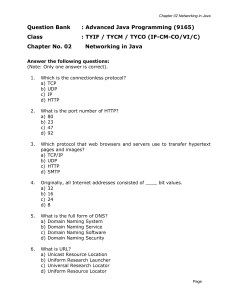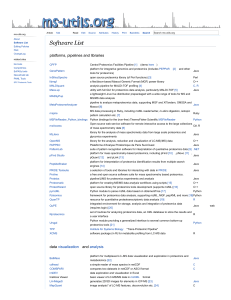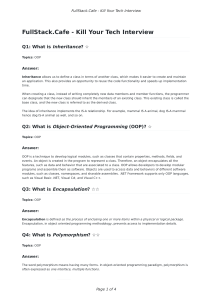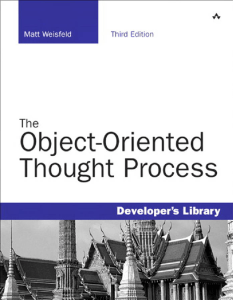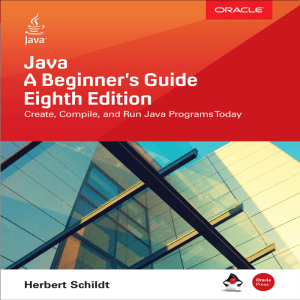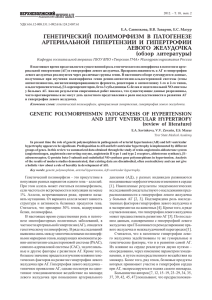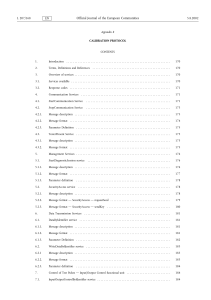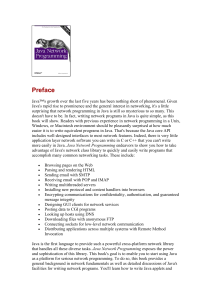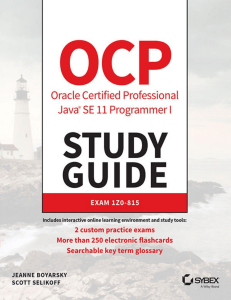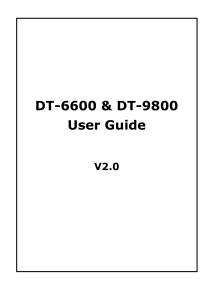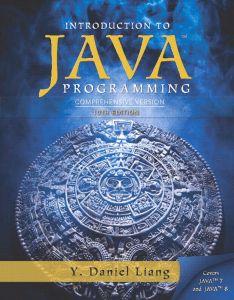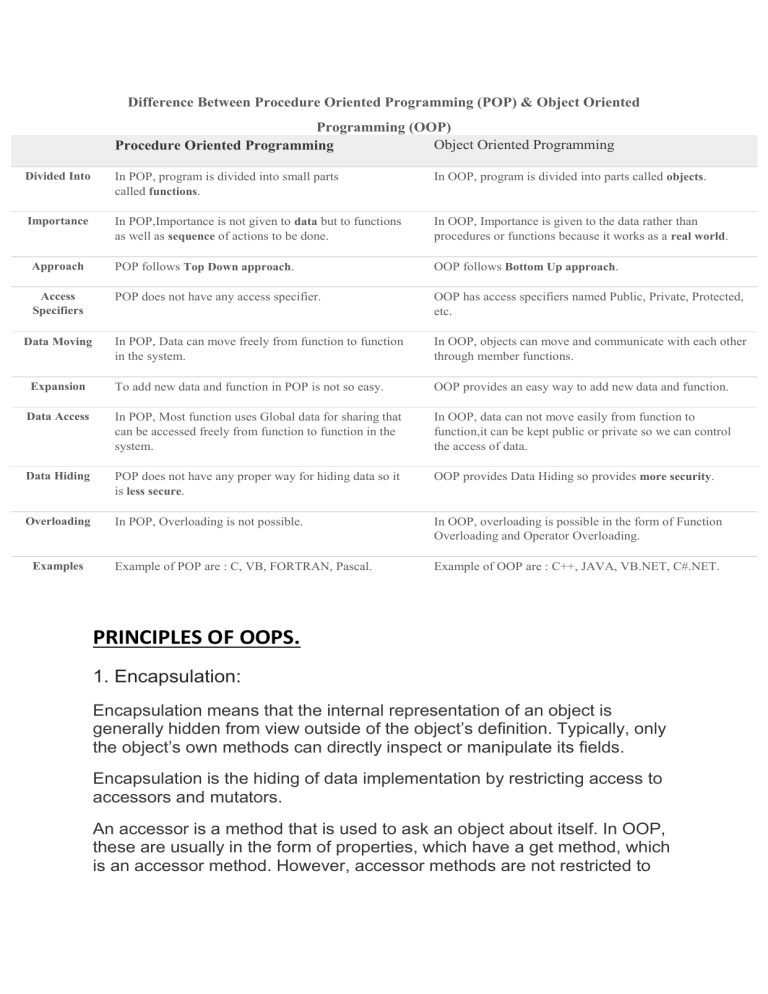
Difference Between Procedure Oriented Programming (POP) & Object Oriented
Programming (OOP)
Object Oriented Programming
Procedure Oriented Programming
Divided Into
In POP, program is divided into small parts
called functions.
In OOP, program is divided into parts called objects.
Importance
In POP,Importance is not given to data but to functions
as well as sequence of actions to be done.
In OOP, Importance is given to the data rather than
procedures or functions because it works as a real world.
Approach
POP follows Top Down approach.
OOP follows Bottom Up approach.
Access
Specifiers
POP does not have any access specifier.
OOP has access specifiers named Public, Private, Protected,
etc.
In POP, Data can move freely from function to function
in the system.
In OOP, objects can move and communicate with each other
through member functions.
To add new data and function in POP is not so easy.
OOP provides an easy way to add new data and function.
Data Access
In POP, Most function uses Global data for sharing that
can be accessed freely from function to function in the
system.
In OOP, data can not move easily from function to
function,it can be kept public or private so we can control
the access of data.
Data Hiding
POP does not have any proper way for hiding data so it
is less secure.
OOP provides Data Hiding so provides more security.
Overloading
In POP, Overloading is not possible.
In OOP, overloading is possible in the form of Function
Overloading and Operator Overloading.
Example of POP are : C, VB, FORTRAN, Pascal.
Example of OOP are : C++, JAVA, VB.NET, C#.NET.
Data Moving
Expansion
Examples
PRINCIPLES OF OOPS.
1. Encapsulation:
Encapsulation means that the internal representation of an object is
generally hidden from view outside of the object’s definition. Typically, only
the object’s own methods can directly inspect or manipulate its fields.
Encapsulation is the hiding of data implementation by restricting access to
accessors and mutators.
An accessor is a method that is used to ask an object about itself. In OOP,
these are usually in the form of properties, which have a get method, which
is an accessor method. However, accessor methods are not restricted to
properties and can be any public method that gives information about the
state of the object.
A Mutator is public method that is used to modify the state of an object,
while hiding the implementation of exactly how the data gets modified. It’s
the set method that lets the caller modify the member data behind the
scenes.
Hiding the internals of the object protects its integrity by preventing users
from setting the internal data of the component into an invalid or
inconsistent state. This type of data protection and implementation
protection is called Encapsulation.
A benefit of encapsulation is that it can reduce system complexity.
2. Abstraction
Data abstraction and encapuslation are closely tied together, because a
simple definition of data abstraction is the development of classes, objects,
types in terms of their interfaces and functionality, instead of their
implementation details. Abstraction denotes a model, a view, or some other
focused representation for an actual item.
“An abstraction denotes the essential characteristics of an object that
distinguish it from all other kinds of object and thus provide crisply defined
conceptual boundaries, relative to the perspective of the viewer.” — G.
Booch
In short, data abstraction is nothing more than the implementation of an
object that contains the same essential properties and actions we can find
in the original object we are representing.
3. Inheritance
Inheritance is a way to reuse code of existing objects, or to establish a
subtype from an existing object, or both, depending upon programming
language support. In classical inheritance where objects are defined by
classes, classes can inherit attributes and behavior from pre-existing
classes called base classes, superclasses, parent classes or ancestor
classes. The resulting classes are known as derived classes, subclasses or
child classes. The relationships of classes through inheritance gives rise to
a hierarchy.
Subclasses and Superclasses A subclass is a modular, derivative class
that inherits one or more properties from another class (called the
superclass). The properties commonly include class data variables,
properties, and methods or functions. The superclass establishes a
common interface and foundational functionality, which specialized
subclasses can inherit, modify, and supplement. The software inherited by
a subclass is considered reused in the subclass. In some cases, a subclass
may customize or redefine a method inherited from the superclass. A
superclass method which can be redefined in this way is called a virtual
method.
4. Polymorphism
Polymorphism means one name, many forms. Polymorphism manifests
itself by having multiple methods all with the same name, but slightly
different functionality.
There are 2 basic types of polymorphism. Overridding, also called run-time
polymorphism. For method overloading, the compiler determines which
method will be executed, and this decision is made when the code gets
compiled. Overloading, which is referred to as compile-time polymorphism.
Method will be used for method overriding is determined at runtime based
on the dynamic type of an object.
Dynamic Method Dispatch or Runtime
Polymorphism in Java
Prerequisite: Overriding in java, Inheritance
Method overriding is one of the ways in which Java supports Runtime Polymorphism. Dynamic method
dispatch is the mechanism by which a call to an overridden method is resolved at run time, rather than
compile time.
When an overridden method is called through a superclass reference, Java determines which
version(superclass/subclasses) of that method is to be executed based upon the type of the
object being referred to at the time the call occurs. Thus, this determination is made at run time.
At run-time, it depends on the type of the object being referred to (not the type of the reference
variable) that determines which version of an overridden method will be executed
A superclass reference variable can refer to a subclass object. This is also known as upcasting.
Java uses this fact to resolve calls to overridden methods at run time.
Therefore, if a superclass contains a method that is overridden by a subclass, then when different types
of objects are referred to through a superclass reference variable, different versions of the method are
executed. Here is an example that illustrates dynamic method dispatch:
// A Java program to illustrate Dynamic Method
// Dispatch using hierarchical inheritance
class A
{
void m1()
{
System.out.println("Inside A's m1 method");
}
}
class B extends A
{
// overriding m1()
void m1()
{
System.out.println("Inside B's m1 method");
}
}
class C extends A
{
// overriding m1()
void m1()
{
System.out.println("Inside C's m1 method");
}
}
// Driver class
class Dispatch
{
public static void main(String args[])
{
// object of type A
A a = new A();
// object of type B
B b = new B();
// object of type C
C c = new C();
// obtain a reference of type A
A ref;
// ref refers to an A object
ref = a;
// calling A's version of m1()
ref.m1();
// now ref refers to a B object
ref = b;
// calling B's version of m1()
ref.m1();
// now ref refers to a C object
ref = c;
// calling C's version of m1()
ref.m1();
}
}
Output:
Inside A's m1 method
Inside B's m1 method
Inside C's m1 method
Explanation :
The above program creates one superclass called A and it’s two subclasses B and C. These subclasses
overrides m1( ) method.
1. Inside the main() method in Dispatch class, initially objects of type A, B, and C are declared.
2. A a = new A(); // object of type A
3. B b = new B(); // object of type B
4. C c = new C(); // object of type C
5. Now a reference of type A, called ref, is also declared, initially it will point to null.
6. A ref; // obtain a reference of type A
7. Now we are assigning a reference to each type of object (either A’s or B’s or C’s) to ref, oneby-one, and uses that reference to invoke m1( ). As the output shows, the version of m1( )
executed is determined by the type of object being referred to at the time of the
call.
8. ref = a; // r refers to an A object
9. ref.m1(); // calling A's version of m1()
ref = b; // now r refers to a B object
ref.m1(); // calling B's version of m1()
ref = c; // now r refers to a C object
ref.m1(); // calling C's version of m1()
Runtime Polymorphism with Data Members
In Java, we can override methods only, not the variables(data members), so runtime
polymorphism cannot be achieved by data members. For example :
// Java program to illustrate the fact that
// runtime polymorphism cannot be achieved
// by data members
// class A
class A
{
int x = 10;
}
// class B
class B extends A
{
int x = 20;
}
// Driver class
public class Test
{
public static void main(String args[])
{
A a = new B(); // object of type B
// Data member of class A will be accessed
System.out.println(a.x);
}
}
Output:
10
Explanation : In above program, both the class A(super class) and B(sub class) have a common
variable ‘x’. Now we make object of class B, referred by ‘a’ which is of type of class A. Since variables
are not overridden, so the statement “a.x” will always refer to data member of super class.
Advantages of Dynamic Method Dispatch
1. Dynamic method dispatch allow Java to support overriding of methods which is central for runtime polymorphism.
2. It allows a class to specify methods that will be common to all of its derivatives, while allowing
subclasses to define the specific implementation of some or all of those methods.
3. It also allow subclasses to add its specific methods subclasses to define the specific
implementation of some.
Static vs Dynamic binding
Static binding is done during compile-time while dynamic binding is done during run-time.
private, final and static methods and variables uses static binding and bonded by compiler while
overridden methods are bonded during runtime based upon type of runtime object
Difference between object and class
There are many differences between object and class. A list of differences between object
and class are given below:
Difference between Encapsulation and
Abstraction in OOPS
Difference between Encapsulation and Abstraction in OOPS
Abstraction and Encapsulation are two important Object Oriented Programming (OOPS) concepts.
Encapsulation and Abstraction both are interrelated terms.
Real Life Difference Between Encapsulation and Abstraction
Encapsulate means to hide. Encapsulation is also called data hiding.You can think Encapsulation like
a capsule (medicine tablet) which hides medicine inside it. Encapsulation is wrapping, just hiding
properties and methods. Encapsulation is used for hide the code and data in a single unit to protect the
data from the outside the world. Class is the best example of encapsulation.
Abstraction refers to showing only the necessary details to the intended user. As the name suggests,
abstraction is the "abstract form of anything". We use abstraction in programming languages to make
abstract class. Abstract class represents abstract view of methods and properties of class.
Implementation Difference Between Encapsulation and Abstraction
1. Abstraction is implemented using interface and abstract class while Encapsulation is implemented
using private and protected access modifier.
2. OOPS makes use of encapsulation to enforce the integrity of a type (i.e. to make sure data is used
in an appropriate manner) by preventing programmers from accessing data in a non-intended manner.
Through encapsulation, only a predetermined group of functions can access the data. The collective
term for datatypes and operations (methods) bundled together with access restrictions (public/private,
etc.) is a class.
3. Example of Encapsulation
Class Encapsulation
{
private int marks;
public int Marks
{
get { return marks; }
set { marks = value;}
}
}
4. Example of Abstraction
abstract class Abstraction
{
public abstract void doAbstraction();
}
public class AbstractionImpl: Abstraction
{
public void doAbstraction()
{
//Implement it
}
}
Comparison Chart
BASIS FOR
INHERITANCE
POLYMORPHISM
COMPARISON
Basic
Inheritance is creating a
Polymorphism is basically a
new class using the
common interface for multiple
properties of the already
form.
existing class.
BASIS FOR
INHERITANCE
POLYMORPHISM
COMPARISON
Implementation
Inheritance is basically
Polymorphism is basically
implemented on classes.
implemented on
function/methods.
Use
To support the concept
Allows object to decide which form
of reusability in OOP and
of the function to be invoked
reduces the length of
when, at compile
code.
time(overloading) as well as run
time(overriding).
Forms
Inheritance may be a
Polymorphism may be a compile
single inheritance,
time polymorphism (overloading)
multiple inheritance,
or run-time polymorphism
multilevel inheritance,
(overriding).
hierarchical inheritance
and hybrid inheritance.
Example
The class 'table' can
The class 'study_table' can also
inherit the feature of the
have function 'set_color()' and a
class 'furniture', as a
class 'Dining_table' can also have
'table' is a 'furniture'.
function 'set_color()' so, which
BASIS FOR
INHERITANCE
POLYMORPHISM
COMPARISON
form of the set_color() function to
invoke can be decided at both,
compile time and run time.
ByteCode is an intermediate code that the java compiler creates after
compiling the java source code. This ByteCode is interpreted by the JRE(Java
Runtime Environment) to run the underlined program.
Q. Why is JAVA PLATFROM INDEPENDENT?
JAVA is platform independent because once the java source code is written
and compiled in a machine, it can be executed in any other type of machine
provided the latter contains a JVM ( JAVA Virtual Machine) for that machine.
JAVA gives this feature by compiling the java source code into intermediate
special language called bytecode which can be interpreted in any machine by
using the JVM for that machine.
Machine code or machine language is a set of instructions executed directly by
a computer's central processing unit (CPU).
Bytecode is platform-independent, bytecodes compiled by a compiler running in windows will still run
in linux/unix/mac. Machine code is platform-specific, if it is compiled in windows, it will run ONLY in
windows.
Portability- Unlike C,C++, there are no “implementation-dependent” aspects of the specification.
The sizes of the primitive data types are specified, as is the behaviour of the arithmetic on them.
Java virtual machine (JVM)
A Java virtual machine (JVM), an implementation of the Java Virtual
Machine Specification, interprets compiled Java binary code
(called bytecode) for a computer's processor (or "hardware platform") so
that it can perform a Java program's instructions. Java was designed to
allow application programs to be built that could be run on
any platform without having to be rewritten or recompiled by the
programmer for each separate platform. A Java virtual machine makes this
possible because it is aware of the specific instruction lengths and other
particularities of the platform.
1)JVM converts the byte code into its equalent excutable
code.
2)It loads the excuteable code into memory(RAM).
3)Excutes this code through local OS.
4)Deletes the excutable code from RAM
JAVA DOES NOT SUPPORT DESTRUCTORS- Java does not support destructor in
the way that c++ provides. C++ has direct destrcors that we can write in our code and it
will clear object once object goes out of scope. But that is not case in Java, you can’t
simply predict when object is going out of scope and when to destroy object, to do this
java has concept called Garbage Collection. Garbage Collector takes care of clearing up
memory allocated to object. It has finalize method which is entirely dicretion of Garbage
Collector. So as in c++ ‘delete’ or ‘free()’ is used to release allocated memory in java that
work is done by finalize and Garbage Collector.So since Java is Garbage Collector
language it does not have destructor.
Java Variables
Java Variables or variables in any other programming language are containers, which
hold some value. Because Java is a strongly typed language, so every variable must be
declared and initialized or assigned before it is used. A variable, in the simplest way, is
declared by placing a valid type followed by the variable name. And so, don't forget to
place a semicolon at the end of every statement because it completes the statement.
Throughout the tutorial we will use terms 'variable' and 'field' interchangeably as they
refer to the same thing and there should be no confusion regarding that. Following
statements demonstrate variable declaration in Java
byte age; //contains -128 to 127
long population;
float temperature;
double salary;
Java Variables - Naming Rules and Conventions
While naming Java variables we have to adhere to some naming rules. Such as:
1. Variable names are case-sensitive.
2. Variable name can be an unlimited-length sequence of Unicode letters and digits.
3. Variable name must begin with either a letter or the dollar sign "$", or the underscore
character "_".
4. Characters except the dollar sign "$" and the underscore character "_" for example, '+' or
'?' or '@' are invalid for a variable name.
5. No white space is permitted in variable names.
6. Variable name we choose must not be a keyword or reserved word.
Additional to above mentioned naming rules Java developers also adhere to some
naming conventions for Java variables but these conventions are totally optional. So it
is your wish if you follow them or not. However, following naming conventions is a
great practice and it makes your program more readable and beautiful. Most prevalent
naming conventions are as follows:
1. Always begin your Java variable names with a letter, not "$" or "_"
2. The dollar sign character, by convention, is never used at all in Java variables. There may
be situations where auto-generated names will contain the dollar sign, but your variable
names should always avoid using it
3. It's technically legal to begin your variable's name with "_" but this practice is
discouraged
4. Choosing full words instead of cryptic abbreviations for variable names are always
considered good, it makes your code easier to read and understand
5. If chosen Java variable name consists of only one word, use all lower-case letters to spell
it. If it consists of more than one word, capitalize the first letter of each subsequent word.
The names firstChoice and reverseGear are good examples of this convention. For
constant valued variables, such as static final int NUM_OF_CHOICES = 7, the
convention changes slightly, capitalizing all letter and separating subsequent words with
the underscore character. By convention, the underscore character is not used elsewhere.
As it has been said, above conventions are not rules therefore they can be compromised
when needed.
Java Variable Types
Java variables are categorized in different types depending upon where are they
declared? For example, in a class or in a method's body. Java defines following four
types of variables.
Local Variables
As name suggests, a local Java variable is scoped to the block, which is between the
opening and closing braces. Local variables are declared within a block or constructor
or method's body. Local variables are created when control enters into the block or
constructor of method's body and are destroyed once the control exits from the body
of method or constructor or block.
Local variables are only visible to the methods or blocks or constructors in which they
are declared; they are not accessible from the rest of the class. There is no designated
access modifier for local variables. Also, there is no default value for local variables,
therefore, local variables must be initialized or assigned some value before they are
used first time.
Instance Variables or Non-Static Fields
Data members or fields or variables of a class that are declared non-static, but outside
a method, constructor or any block are known as instance variables. Instance
variables are created when an object of a class is created by using new keyword. Objects
store their states in non-static instance variables. Instance variables are declared
private or public or protected or default (no keyword). Instance variables are
initialized to some default values by the compiler, in case they are not initialized by the
creator of class. Instance variables are destroyed along with the object they have been
created for. The following program declares some non-static instance variables:
/* Book.java */
class Book
{
//instance variables
private String title;
private String publisher;
private int numOfPages;
//zero argument constructor needed when
//one or more argument constructors are defined
public Book() {}
public Book (String title, String publisher, int numOfPages)
{
this.title = title;
this.publisher = publisher;
this.numOfPages = numOfPages;
}
public void printBookDetails()
{
System.out.println("Title: " + title);
System.out.println("Publisher: " + publisher);
System.out.println("Num of Pages: " + numOfPages);
}
}
Class Variables or Static Fields
Class variables in Java are fields declared with static keyword.
Modifier staticinforms the compiler that there will be only one copy of such variables
created regardless of how many objects of this class are created. Static variables are
created when a class is loaded into the memory by the class loader and destroyed when
a class is destroyed or unloaded. Visibility of static fields will depend upon access
modifiers. Default vales given to the static members will follow the same rule as it is
done in instance variables.
Method Parameters
While passing values to member methods we need parameter variables. Parameters
are not fields; they are always called variables and used only to copy their values into
the formal parameters. Variables or values passed to a method by caller are called
actual parameters, and the callee receives these values in formal parameters. Formal
parameters are local variables to that particular method.
Java Variables - Dynamic Initialization
Initialization is the process of providing value to a variable at declaration time. A
variable is initialized once in its life time. Any attempt of setting a variable's value after
its declaration is called assignment. To use a local variable you have to either initialize
or assign it before the variable is first used. But for class members, the compulsion is
not so strict. If you don't initialize them then compiler takes care of the initialization
process and set class members to default values.
Java allows its programmers to initialize a variable at run time also. Initializing a
variable at run time is called dynamic initialization. The following piece of code
(DynamicInitializationDemo.java) demonstrates it.
/* DynamicInitializationDemo.java */
public class DynamicInitializationDemo
{
public static void main(String[] args)
{
//dynSqrt will be initialized when Math.sqrt
//will be executed at run time
double dynSqrt = Math.sqrt (16);
System.out.println("sqrt of 16 is : " + dynSqrt);
}
}
OUTPUT
======
sqrt of 16 is : 4.0
Java Variables - Intermediate Type Promotion
In some situations intermediate result of an expression is out of range of the variable
to which the final result has to be assigned, while the final result is in variable's range?
Let's consider an example where we have to compute average age of three
octogenarians. Suppose we store individual's and average age in byte variables. The
ages of all three are 82, 87, and 89 years respectively. Now to compute the average of
their age you first have to add all three ages together and then divide it by 3. But, if you
see, as soon as you add all three ages you will get 258 that is beyond the range
of byte (127 is the largest positive value a byte can store), while the final averaged age
86 that is in the range of byte.
Java handles this situation very smartly by promoting intermediate results to integer.
But it imposes an extra overhead on programmers to cast results back to the resultant
type, byte in our case. See the following piece of code.
/* TypePromotionDemo.java */
public class TypePromotionDemo
{
public static void main(String[] args)
{
byte age1 = 82, age2 = 87, age3 = 89;
byte avgAge = (byte) ((age1 + age2 + age3) / 3); //cast int to byte
System.out.println("Average age is : " + avgAge);
}
}
OUTPUT
======
Average age is : 86
In addition to the elevation of byte to int, Java defines several type promotion rules
that apply to expressions. First, all byte and short values are promoted to int, as just
described. Then, if one operand is a long, the whole expression is promoted to long. If
one operand is a float, the entire expression is promoted to float. If any of the
operands is double, the result is double.
Java Variables - Type Conversion and Type Casting
When value of one variable is assigned to another or a literal is assigned to a variable
then either automatic type conversion takes place or we have to type cast explicitly.
Automatic type conversion is done when either both sides (left and right) are of same
type or the left hand (destination) side is larger in size. The latter is called widening.
For example, assigning byte to short or int to long.
If we wish to assign incompatible types then we will have to type cast at our own and
according to the problem for example, int to short conversion will not be done
automatically, because short is smaller than int. In this case we will have to explicitly
cast it and this conversion is called narrowing.
Java is Statically Typed Language
Note that Java is a statically-typed language that means the type of a variable must be
known at compile time, as type checking is done during compilation of the code. The
main advantage static typing offers is that type checking is done by the compiler before
the program is executed. The compiler can therefore deduce whether or not a given
variable is capable of performing actions requested of it. For example, the following
piece of code will result into compilation error.
/* StaticTypedDemo.java */
public class StaticTypedDemo
{
public static void main(String[] args)
{
byte s = 90;
s = s + 2; // Type mismatch: cannot convert from int to byte
System.out.println(s);
}
}
Because, in statement s = s + 2; the intermediate term s + 2 is automatically promoted
to int and therefore, cannot be assigned to a byte without the use of a cast. The same
example also illustrates the strong type checking that Java places severe restrictions
on the intermixing of operations that is permitted to occur.
ASCII defines 128 characters, which map to the numbers 0–127. Unicode defines (less
than) 221characters, which, similarly, map to numbers 0–221 (though not all numbers are
currently assigned, and some are reserved).
Unicode is a superset of ASCII, and the numbers 0–128 have the same meaning in
ASCII as they have in Unicode. For example, the number 65 means "Latin capital 'A'".
Because Unicode characters don't generally fit into one 8-bit byte, there are numerous
ways of storing Unicode characters in byte sequences, such as UTF-32 and UTF-8.
Unicode vs ASCII
ASCII and Unicode are two character encodings. Basically, they are
standards on how to represent difference characters in binary so that
they can be written, stored, transmitted, and read in digital media.
The main difference between the two is in the way they encode the
character and the number of bits that they use for each. ASCII
originally used seven bits to encode each character. This was later
increased to eight with Extended ASCII to address the apparent
inadequacy of the original. In contrast, Unicode uses a variable
bit encoding program where you can choose between 32, 16, and 8bit encodings. Using more bits lets you use more characters at the
expense of larger files while fewer bits give you a limited choice but
you save a lot of space. Using fewer bits (i.e. UTF-8 or ASCII) would
probably be best if you are encoding a large document in English.
One of the main reasons why Unicode was the problem arose from
the many non-standard extended ASCII programs. Unless you are
using the prevalent page, which is used by Microsoft and most
other software companies, then you are likely to encounter problems
with your characters appearing as boxes. Unicode virtually
eliminates this problem as all the character code points were
standardized.
Another major advantage of Unicode is that at its maximum it can
accommodate a huge number of characters. Because of this, Unicode
currently contains most written languages and still has room for even
more. This includes typical left-to-right scripts like English and even
right-to-left scripts like Arabic. Chinese, Japanese, and the many
other variants are also represented within Unicode. So Unicode won’t
be replaced anytime soon.
In order to maintain compatibility with the older ASCII, which was
already in widespread use at the time, Unicode was designed in such
a way that the first eight bits matched that of the most popular ASCII
page. So if you open an ASCII encoded file with Unicode, you still get
the correct characters encoded in the file. This facilitated the
adoption of Unicode as it lessened the impact of adopting a new
encoding standard for those who were already using ASCII.
Summary:
1.ASCII uses an 8-bit encoding while Unicode uses a variable bit
encoding.
2.Unicode is standardized while ASCII isn’t.
3.Unicode represents most written languages in the world while
ASCII does not.
4.ASCII has its equivalent within Unicode
A symbolic constant is an "variable" whose value does not change during the
entire lifetime of the program. There are no symbolic constants in java. Final
variables serve as symbolic constants. A final variable
declaration is qualified with the reserved word final. The
variable is set to a value in the declaration and cannot be
reset. Any such attempt is caught at compile time.
final double PI = 3.14 ;
They are constants because of the 'final' keywords, so they canNOT be reassigned a new value
after being declared as final
And they are symbolic , because they have a name
They can’t be declared inside a method . they should be used only as class data
members in the beginning of the class.
Cast Operator:
1. Cast operator is used to convert numeric values from one numeric type to another or
to change an object reference to a compatible type.
2. Used to enable conversions that would normally be disallowed by the compiler. a
reference of any object can be cast to a reference of type Object
3. a reference to an object can be cast into a reference of type ClassName if the actual
class of the object, when it was created, is a subclass of ClassName.
4. a reference to an object can be cast into a reference of type InterfaceName if the class
of the object implements Interface, if the object is a subinterface of InterfaceName or if
the object is an array type and InterfaceName is the Cloneable interface.
The difference is that the short circuit operator doesn't evaluate the second operand if the
first operand is true, which the logical OR without short circuitalways evaluates both
operands.
Static Method: Restrictions.
a. Access only static type data (static type instance
variable).
b. Call only static method ,if non-static then compile
time error.
c. No need the class object to call the static method.
d. Cant use this and super keyword otherwise compile time
error.
Method Overloading
Method Overriding
Definition
In Method Overloading, Methods of the same class shares
the same name but each method must have different number
of parameters or parameters having different types and order.
In Method Overriding, sub class have the same
method with same name and exactly the same number
and type of parameters and same return type as a
super class.
Meaning
Method Overloading means more than one method shares the
same name in the class but having different signature.
Method Overriding means method of base class is redefined in the derived class having same signature.
Behavior
Method Overloading is to “add” or “extend” more to
method’s behavior.
Method Overriding is to “Change” existing behavior
of method.
Overloading and Overriding is a kind of polymorphism.Polymorphism means “one name, many forms”.
It is a compile time polymorphism.
It is a run time polymorphism.
It may or may not need inheritance in Method Overloading.
It always requires inheritance in Method Overriding.
Signature
In Method Overloading, methods must have different
signature.
In Method Overriding, methods must have same
signature.
Relationship of
Methods
In Method Overloading, relationship is there between
methods of same class.
In Method Overriding, relationship is there between
methods of super class and sub class.
In Method Overloading, methods have same name different
signatures but in the same class.
In Method Overriding, methods have same name and
same signature but in the different class.
Method Overloading does not require more than one class for
overloading.
Method Overriding requires at least two classes for
overriding.
Class Add
Class A
{
{
Polymorphism
Inheritance
Criteria
No. of Classes
Example
// Super Class
int sum(int a, int b)
void display(int num)
{
{
return a + b;
print num ;
}
}
int sum(int a)
}
{
//Class B inherits Class A
return a + 10;
}
Class B //Sub Class
{
}
void display(int num)
{
print num ;
}
}
